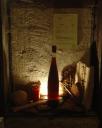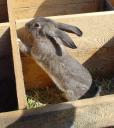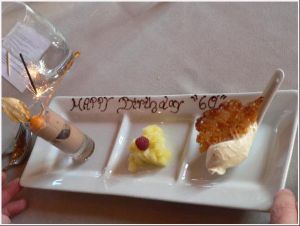To download an Adobe Acrobat version click on this link E2EYear5Weeks49-Year6Week6.pdf
You can click on the photos to see larger versions
While Sarko and Sego were busy fighting it out for the hearts, souls and votes of the French nation, one of the local history groups had an earlier battle in mind, that of Frapelle in 1918. Some of you encountered Frapelle during John’s birthday festivities as the Sainte Claire walk and quiz started and finished there and one of the questions asked what vestiges of World War 1 you could spot. (The answer was: farmhouse ruins, trenches, shell holes). The local historians’ April lecture intriguingly included Americans and chemical warfare as well as Frapelle in its title.
It is hard to recall an era in which our American friends were innocent about chemical warfare. But the lecturer revealed that all that the American 5th Division, the Red Diamond, knew about chemical warfare after their training in Texas came from a six day course on gas for officers, followed by a 40 minute lecture to their troops. So they came to the Vosges, Anould sector, to learn the practicalities of attack and decontamination alongside the hardened and exhausted French troops. After that, their first solo engagement was at Frapelle. The lecturer’s assessment (French) was that they gained a little ground, but the villages were destroyed. The official history (American) of the 5th Division claims, more grandly, that it was “the diamond that cut into the battle line of the Vosges in August, 1918, and by the capture of the village of Frapelle made the only indentation suffered by the Germans in their southern sectors in three years of trench warfare.” The main gas casualties were not in Frapelle itself but in the deep ravines of no-man’s land, which formed the only communication lines and where the mustard gas lingered.
The day after the lecture, we got caught up in the presidential battle. It was a gloriously sunny Sunday and everyone was hyped up by the debate and heading down to the local marie to register their vote in the first round of the presidential election. So villages which had chosen that day for their village flea market had a traffic control problem. The first village we went to was a small picturesque Lorraine village perched on a hilltop. The cars bearing the elderly voters had to be allowed up the hill to the door of the marie, and the main square kept clear for their parking. So the stalls were in the small side-streets, and the tourists parked under the elegant row of horse chestnuts at the foot of the hill and strolled up admiring the steep colourful gardens. At the end of the day it was announced that both Sarko and Sego were through to the next round, despite Entre-deux-Eaux marginally preferring Sarkozy and Le Pen and Mandray’s favourite being Le Pen, followed by Sarkozy. Interestingly, our flea-market hill-top village had gone, more liberally, for Sarkozy and Bayrou.
The following Sunday was the day of the Gérardmer Daffodil Festival. Unfortunately, due to the mild winter and an early heat-wave, the daffodils had flowered in the high pastures around Gérardmer well before their usual date. The floats would be struggling to cover themselves in golden blooms. So we ignored the festival and went off to the annual lard fair and flea market at St Rémy, which is more picturesque than it sounds.  We did very well on purchases there, and John was also much taken by a group of cows recumbent in front of beehives, looking smugly like honey-makers. Driving home beneath lowering skies, our car radio, broadcasting from the Gérardmer Festival, announced that in the event of transmission being disrupted by the approaching storm, music would be played. The heavens opened just as we reached home. The Gérardmer procession, low on daffodils, must have been a battered and bedraggled affair.
We did very well on purchases there, and John was also much taken by a group of cows recumbent in front of beehives, looking smugly like honey-makers. Driving home beneath lowering skies, our car radio, broadcasting from the Gérardmer Festival, announced that in the event of transmission being disrupted by the approaching storm, music would be played. The heavens opened just as we reached home. The Gérardmer procession, low on daffodils, must have been a battered and bedraggled affair.
By the time Leila came to stay in May, we were doing well on our flea-market purchases. John’s prize purchase so far had been a silver-plated device for sweeping the crumbs off table cloths between courses (a major preoccupation in some restaurants, which had fascinated Viv on a visit). So when he spotted a slightly mangy crumb-sweeper in a cardboard box of oddments in a picturesque market beneath the shady churchyard trees he couldn’t resist bargaining for it on Viv’s behalf. With Leila we set off confidently for two flea markets in the plains of Alsace. The Alsace markets are much larger than our Lorraine ones, attracting dealers from over the Rhine in Germany. The first one was no exception. It was huge and very hot. The stalls started just by the marie. And unfortunately it was also the day of the second round of presidential voting. The roads leading to the marie were packed with crawling, hooting cars containing frustrated voters trying to edge through the throngs of acquisitive visitors. By the second village, most people seemed to have voted already. In the food and beer tent one unsteady gentleman in a crumpled striped linen jacket was eyeing up and chatting up all the attractive young women. He’d clearly been celebrating his participation in the democratic process since early morning. It may have been the heat, or maybe the sheer size of the markets, but after a while all the stalls began to look the same, and we left, exhausted, with nothing. Later that evening Sarkozy’s victory was announced. I wonder if that occasioned further celebration by the crumple-jacketed man.
It was also while Leila was with us that I started to notice a stain on the ceiling over my side of our bed and heard strange noises. And before travelling back to Nottingham with Leila, I was complaining about an unpleasant smell in the bedroom. So John was on his own by the time the smell got overwhelming and he was forced to cut a square out of the ceiling. I won’t go into the intricacies of our roof slope and inaccessible cavities. Sufficient to say that he discovered that a large black bird had somehow got trapped in a cavity and died above our bed, decomposition being aided by the hot weather and maggots. From a safe distance I felt very sorry for John, and followed his progress in disinfecting, filling, plastering and painting over the hole. But by the time I got back, there was a fresh damp patch on the new paintwork and a different unpleasant smell. So the ceiling was carved open again and sizeable cat-like droppings discovered. After considerable research and consultation John decided that we had a resident stoat or marten. So we started to consider our own chemical warfare.
Stoats are a protected species here, unless in specific instances they have been labelled a public nuisance. The website advice was to check at the mairie. However, on the principle that one of the mayor’s deputies, being a farmer, might feel less constrained by the letter of the law, we consulted Farmer Duhaut when he was passing on his tractor. He offered, providing we didn’t tell anyone, especially not the mayor, to put poison in a couple of their hens’ eggs (to which stoats are very partial). We should place the eggs by the entry hole under the eaves, well out of reach of any other animal. He swore that the poison was so effective that the stoat would be dead within 4 metres. However, the prospect of a second inaccessible decaying body was not appealing. So John went hunting for old-fashioned mothballs containing naphthalene. It has to be said that the smell of Jeyes fluid (sprayed into the cavity and on the outside walls) and mothballs was very pleasant after that of urine, faeces and decay. It remains to be seen how long-term a deterrent it is. There was also a series of small earthquakes while I was away, but they caused less disruption or damage than the stoat.
Outside in the garden, life was proceeding more smoothly. John had finally purchased a sit-on mower, which arrived round about the time he also realised he was suffering from hay fever. Perhaps I shouldn’t have used the word “smoothly”, as it turned out to be very bumpy riding the bucking mower over our fields. He also got the rotavator working again, which was a great boon in preparing the vegetable patch this year. Nevertheless, everyone else had neat rows of seedlings sprouting in their potagers before I finished sowing ours. Given that we’re planning to be away (UK and a Greek island) during the key watering and harvesting time in July and August, we’ve concentrated on more winter vegetables like leeks, carrots, parsnip, beetroot, celeriac, chard, leaf beat, fennel, and Brussels sprouts with an exception for sweetcorn, salad and okra. Our futile chemical warfare against Colorado beetles last summer made potatoes an unattractive option for this year. I realised how much I dislike wildlife in the garden, rather than at a civilised distance from the house, when a mole began its earth-workings in the strawberry bed, a small tunnel opened up under the Brussels sprouts and a grass snake slithered out of the compost heap. Now why doesn’t the stoat eat all of them?
Meanwhile, back on the political front, the election of deputés for the National Assembly was hotting up. We had been a bit disconcerted to receive an invitation to meet the ambitious mayor of Saint-Dié, as he has no jurisdiction over the peasants of Entre-deux-Eaux. But then we realised that he was standing as our deputé. He was due in Mandray about 15 minutes before he was due in Entre-deux-Eaux, so was clearly on a whistle-stop campaign tour. At that speed he couldn’t be expecting direct speech with too many people at either venue. Anyway, as we gardened we were not aware of a either a mayoral cavalcade or a rush of cars heading to meet him that afternoon.
Was it sheer coincidence that the long-heralded TGV was due to make its first high-speed journey to Saint-Dié during the election campaign? Both the existing deputé and the hopeful mayor were of course claiming credit for the faster connections to Paris and the rest of the world. A weekend of processions, bands and dancing was planned for Saint-Dié. We couldn’t hear the band when we went into town at the advertised time. Maybe the wind had wafted away the strains. There turned out to be only four musicians in tropical safari kit strolling round rather half-heartedly in the drizzle with three girls in red with red balloons and leaflets. So uninterested was the general public, that no one was following the band and John had the greatest difficulty persuading one of the scarlet girls that he would indeed like a leaflet. The fares seem very high and the frequency much reduced from the original proposals.
You might think from our web-site photos that we have done nothing since our last newsletter but dine out. At the risk of confirming this impression (and with the accompanying plea that Roger and Dorinda lead us astray when they are here) I must just mention the our trip to the Ducs de Lorraine at Epinal. Epinal has never been one of our favourite towns. The administrative and shopping centre has been extensively rebuilt post-war, and our visits have largely taken us to modern museums and modern departmental administrative blocks. So it was a pleasure to park on the tree-lined river bank and walk through the ornamental railings towards an elegant mansion from the belle époque. We swept up the stone staircase and into a dark panelled hallway, off which opened a large airy room, with lemon coloured walls, long windows and dripping chandeliers. Its tables were crisp with linen cloths and bristling with cutlery and glasses. A traditional French restaurant, complete with waiters in waistcoats and striped trousers. Badly done, these stage-effects can be off-putting and snobbish, but there was a comfortable, relaxed atmosphere, and Roger and Dorinda were already ensconced outside under the awning of the more informal terrace. Our amuses bouches, starters and main course were beautifully prepared (though we were sorry not to get the flaming crème brulée amuse bouche which was presented with drama to a neighbouring table). For some time Roger had been lamenting the demise of the opulent cheese board, even in “good” but trendy restaurants. Therefore great was his joy when a laden cheese trolley appeared. But even that was eclipsed by the desert trolley; choice was not a problem as one could mix and match discreetly, a few cherries, melon, peaches, strawberries, white chocolate and nut gateau, peach tart, rhubarb tart, crème anglais … and then, unbeknown to us, some, like the skewers of fresh fruits and the tarte tatin, were whisked away to be grilled or reheated and garnished with fresh fruit and sorbet … so after cold and a hot desserts we needed a leisurely coffee in order to recover.
Before Roger and Dorinda left Mandray for their parallel lives in the UK, we had a sunny day of flea marketing together in small Lorraine villages. The highlights were Roger’s lengthy discussion with an amateur rabbit breeder in a village with a pretty Romanesque church; the old glass-making village with its restored water mill wheel, its fanfare of French horns by the old factory gates, and its glass-shop among the ruins of the old factory;  a brief stop to photograph the Indian war graves in a tiny British military cemetery; and finally my purchase of a biscuit box in Housseras. Now I’m not the kind of person who feels that life is incomplete without a biscuit box, but somehow this wooden box just drew me to bargain for it, without knowing how I would use it. “A box in the barn for all your seeds?” suggested Dorinda.
a brief stop to photograph the Indian war graves in a tiny British military cemetery; and finally my purchase of a biscuit box in Housseras. Now I’m not the kind of person who feels that life is incomplete without a biscuit box, but somehow this wooden box just drew me to bargain for it, without knowing how I would use it. “A box in the barn for all your seeds?” suggested Dorinda.
This magical box is very basic plain orange-box type wood, about 13 x 9 x 10 inches (you can calculate for yourselves how many biscuits it would hold, choosing your preferred size of biscuit). On its lid is printed in dark brown ink an elaborate picture of a shop in Reims, complete with diamond paned windows, steep gabled roof, displays of biscuits and the words Biscuits Ch Tarpin, massepains, pain d’épices, médaille d’or l’exposition universelle 1900. The lid also has a hand-written label showing it being sent via Saint-Dié railway station to a gentleman who lived on the same Saint-Dié street as our doctor, where the houses are prosperous neo-Renaissance and Art nouveau villas. Cobwebs and ingrained dust cleaned off, the biscuit box now resides in our bathroom. It’s a good size for storing those bulky packets of spare toilet rolls and bars of soap (should you ever need to find them).
Our purchases from the Entre-deux-Eaux flea market the following week were even more successful. Although it was the day for the second round in the elections for National Assembly deputés, there was no traffic problem here, apart from one sign which was at an odd angle and appeared to point down our road. While voting was at the mairie in the centre of the village, the firemen had the flea market parking efficiently organised opposite the football pitch a couple of kilometres away on the outskirts of the commune. As the morning temperatures turned from hot to blazingly hot, we looked at quite a few things, but didn’t buy. After a coffee back home we drove over to the tiny village of Fremifontaine where John bought an old Ultrafex camera to add to his collection and we had this year’s best chips served in copious quantities. In the late afternoon, as I watched Federer and Nadal battle it out in the finals of the French Open, John returned to the football pitch and got two further old cameras and a cast iron Le Creuset “thing” which has become the object of correspondence and speculation. Someone sent mouth-watering pictures of food being cooked on a Korean reverse wok and finally Le Creuset confirmed that it was a chaudière and promised a recipe book.
The next day it was apparent that Entre-deux Eaux was almost persuaded by the eloquence of the mayor of Saint-Dié. 49.75% of our voters supported him (101 votes) against 50.25% of votes for the existing deputé (102 votes) (there were 175 abstentions/blank votes!). Across the district, the existing candidate won by 54.99%, a slightly larger majority.
 And finally, a soothing photo of a charming and cool café, L’Epicerie, in Strasbourg where we sank down for a welcome drink at the end of a sweltering day a couple of days ago. We have had several trips recently to Strasbourg, after I had a malignant melanoma on my arm removed, followed by tests and surgery to remove further tissue and to do a skin graft. It was interesting to explore the old hospital quarter afterwards as well as the more touristy streets. And this café was the treat at the end! The storm clouds gathered as we drove back towards the Vosges, and the thunder has been grumbling and the rain falling ever since. That should encourage the vegetable seedlings to grow as big as those of everyone else!
And finally, a soothing photo of a charming and cool café, L’Epicerie, in Strasbourg where we sank down for a welcome drink at the end of a sweltering day a couple of days ago. We have had several trips recently to Strasbourg, after I had a malignant melanoma on my arm removed, followed by tests and surgery to remove further tissue and to do a skin graft. It was interesting to explore the old hospital quarter afterwards as well as the more touristy streets. And this café was the treat at the end! The storm clouds gathered as we drove back towards the Vosges, and the thunder has been grumbling and the rain falling ever since. That should encourage the vegetable seedlings to grow as big as those of everyone else!
I couldn’t resist a post-script: This morning we were wandering round the hospital quarter of Strasbourg yet again, admiring the old buildings, like the Pavillon Leriche with its verandas, on which you could imagine the wounded heroes of World War 1 patiently lying in the sunshine. In places you could still see fading lettering in German. Being a Saturday it was pretty deserted. Then we came to an elegant gabled eighteenth century building from the cellars of which a man was carrying cartons of wine. Intrigued, we went down the steps to the heart of the hospital’s wealth.  For these cool vaulted cellars date from 1395, from the days when people would often pay their hospice bills by giving tracts of land (usually vineyards), or on their death bequeath land. One of the long rows of antique oak barrels even contains wine from1472, a legendary vintage, which is still maturing! John was allowed a sniff and said it smelt very sweet, almost like sherry! At the far end is a door through which the bodies from executions were secretly brought in to the dissecting rooms. When the original hospice burned down the cellars remained intact. The wines of many renowned Alsace growers are now sold from there under a special label with 1395 Cave historique Hospices Strasbourg above the type, year and producer. The first bottles we saw were from Bruno Hertz, in whose Eguisheim cellars we tasted our first Gewürztraminer thirty years ago. This self-effacing man is now president of the group! Some of the profits purchase hospital equipment like a colour ultrasound machine for the maternity unit. So if you fancy a wine with a difference, place your orders now – but the 1472 is not yet available! Doesn’t it just give depth of meaning to the toast Santé!
For these cool vaulted cellars date from 1395, from the days when people would often pay their hospice bills by giving tracts of land (usually vineyards), or on their death bequeath land. One of the long rows of antique oak barrels even contains wine from1472, a legendary vintage, which is still maturing! John was allowed a sniff and said it smelt very sweet, almost like sherry! At the far end is a door through which the bodies from executions were secretly brought in to the dissecting rooms. When the original hospice burned down the cellars remained intact. The wines of many renowned Alsace growers are now sold from there under a special label with 1395 Cave historique Hospices Strasbourg above the type, year and producer. The first bottles we saw were from Bruno Hertz, in whose Eguisheim cellars we tasted our first Gewürztraminer thirty years ago. This self-effacing man is now president of the group! Some of the profits purchase hospital equipment like a colour ultrasound machine for the maternity unit. So if you fancy a wine with a difference, place your orders now – but the 1472 is not yet available! Doesn’t it just give depth of meaning to the toast Santé!






